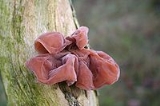
Auricularia
Encyclopedia
Auricularia is a genus
of jelly fungi
in the family
Auriculariaceae
. There are about eight species described in this genus, which has a widespread distribution.
, while de-emphasizing traditional characteristics such as color, shape and size, which he considered to be too variable and dependent upon such factors as the age of the specimen, exposure to light, or availability of moisture. The characteristics he emphasized were the presence or absence, width and morphology of the medulla (the part composed mainly or entirely of longitudinal hypha
e), and the length of the abhymenial hairs, features that are currently used in defining species in this genus.
Genus
In biology, a genus is a low-level taxonomic rank used in the biological classification of living and fossil organisms, which is an example of definition by genus and differentia...
of jelly fungi
Jelly fungi
The class Heterobasidiomycetes or jelly fungi is a paraphyletic group of several fungal orders: Tremellales, Auriculariales, Dacrymycetales. These fungi are so named because their foliose to irregularly branched fruiting body is, or appears to be, the consistency of jelly. Actually, many are...
in the family
Family (biology)
In biological classification, family is* a taxonomic rank. Other well-known ranks are life, domain, kingdom, phylum, class, order, genus, and species, with family fitting between order and genus. As for the other well-known ranks, there is the option of an immediately lower rank, indicated by the...
Auriculariaceae
Auriculariaceae
The Auriculariaceae are a family of fungi in the order Auriculariales. Species within the family were formerly referred to the "heterobasidiomycetes" or "jelly fungi", since many have gelatinous basidiocarps that produce spores on septate basidia. Around 100 species are known worldwide. All are...
. There are about eight species described in this genus, which has a widespread distribution.
Classification
Lowy, in 1951, described a key to the species of Auricularia that emphasized the internal structure of the fruit bodySporocarp (fungi)
In fungi, the sporocarp is a multicellular structure on which spore-producing structures, such as basidia or asci, are borne...
, while de-emphasizing traditional characteristics such as color, shape and size, which he considered to be too variable and dependent upon such factors as the age of the specimen, exposure to light, or availability of moisture. The characteristics he emphasized were the presence or absence, width and morphology of the medulla (the part composed mainly or entirely of longitudinal hypha
Hypha
A hypha is a long, branching filamentous structure of a fungus, and also of unrelated Actinobacteria. In most fungi, hyphae are the main mode of vegetative growth, and are collectively called a mycelium; yeasts are unicellular fungi that do not grow as hyphae.-Structure:A hypha consists of one or...
e), and the length of the abhymenial hairs, features that are currently used in defining species in this genus.
Species
- A. americana
- A. auricula-judaeAuricularia auricula-judaeAuricularia auricula-judae, known as the Jew's ear, jelly ear or by a number of other common names, is a species of edible Auriculariales fungus found worldwide. The fruiting body is distinguished by its noticeably ear-like shape and brown colouration; it grows upon wood, especially elder...
- A. cornea
- A. delicata
- A. fuscosuccinea
- A. mesenterica
- A. peltata
- A. polytricha
- A. sordescens

